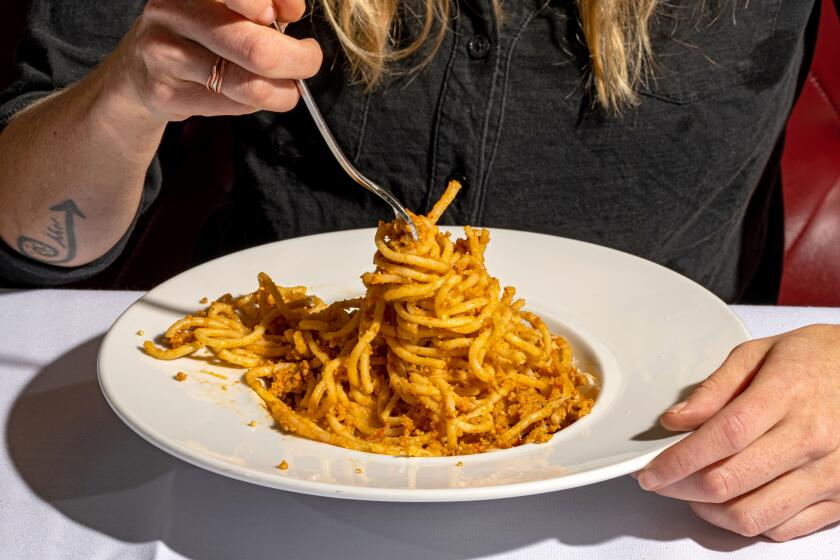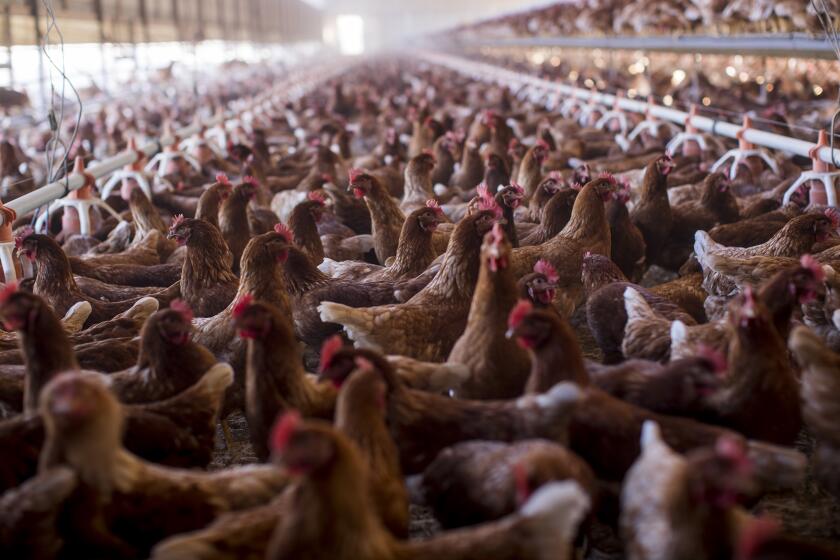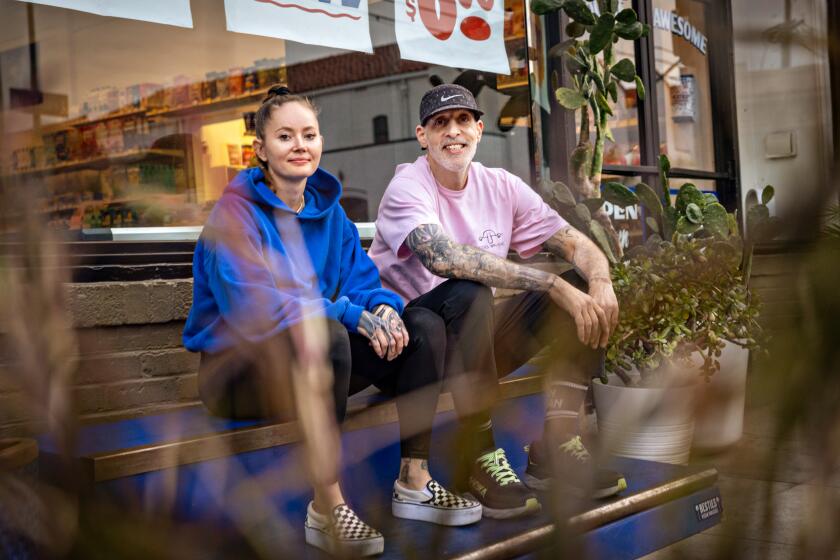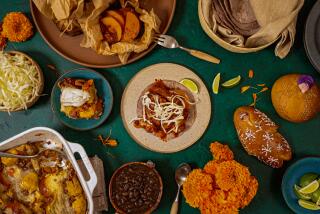Meat is central to my cultural heritage. Here’s how I gave it up

- Share via
My earliest memories of food are of family barbecues.
My late father grew up on a cattle ranch in Uruguay, a country where there are three times as many cows as people. It’s one of the world’s top consumers of beef per capita; Uruguayans eat an average of 200 pounds of meat a year. Meanwhile, my mother is from Kansas City, Mo., which is renowned for its slow-smoked barbecue.
So when I decided to switch to a plant-based diet in 2007, it was an understatement to say that my parents and I were at odds. I wasn’t cutting out just a food group from my diet but a significant aspect of my cultural identity.
I was born in California in 1989. But when I was 3, my family moved to Uruguay. I have an early memory at the butcher where my abuela placed two massive cow tongues — one in each of my hands — and asked me which one felt heavier.
If you’re a woman in your 40s whose body can no longer tolerate alcohol, you’re not alone. Researchers explain why drinking gets harder as we enter perimenopause.
The tongue was for an asado, a cultural tradition started by gauchos (Uruguayan cowboy cattle ranchers) of grilling meat on a parrilla, which is an open-air wood fire outdoor grill. These were occasions where, amid the chatter of our friends and family, my father would encourage me to try bites of mystery meat cuts.
“I grilled these for you with love,” he’d say, leaving me no choice but to try what he’d handed me. Only after I’d taken a bite would he reveal what I’d eaten: a brain, an intestine, a bull testicle.
When we moved to Kansas City about a year later, asados were replaced with sprawling KC-style cookouts. My maternal family is large, so when we go out to eat, there’s usually more than 20 of us. For as long as I can remember, we’ve been loyal to Arthur Bryant’s, a barbecue spot in downtown Kansas City. As a child, I loved eating ribs doused in sweet tangy KC BBQ sauce made with molasses, acidic vinegar and spicy chile powder alongside my cousins.
At 17, I moved to Los Angeles for college. Up until that point in my life, eating meat wasn’t something I questioned. Though I never really enjoyed chicken, turkey or lamb, I consumed red meat often. This delighted my father, who considered that trait to mean I was a good Uruguayan. But despite enjoying red meat, I had no idea how to prepare it. My father was the keeper of the grill, and he held the knowledge of how to select a cut, season and cook it.
The first time I went to the grocery store in Los Angeles, I stood in the meat aisle overwhelmed. It was the summer of 2007 and the U.S. was on the brink of an economic crisis. The slabs of flesh were expensive, and the thought of handling them disturbed me. So I decided not to buy any. That’s how I stopped eating meat. Originally, it wasn’t a decision based on morals, animal rights, environmental conservation or optimal health — I just went with my gut.
Whether you’re already a plant-forward person or contemplating a change in diet, here are 30 restaurants to check out.
I soon found my new dietary choice was a challenge for my family to accept. Two months later, I flew home to surprise my sister for her 14th birthday. When I told my parents and sister I wasn’t eating meat, they were puzzled — my mom had made fried chicken for dinner. They weren’t open to discussing the benefits of a plant-based diet. And their lack of support made me feel misunderstood. But I also decided that it wasn’t their responsibility to cater to my dietary preferences. That night, I filled up on salad and potatoes instead.
I later learned that there were a lot of complicated factors at play in our exchange.
“In Latinx culture, food is central to family and community gatherings,” says Vanessa Palomera, a Mexican American therapist based in Dallas. “When someone goes vegan, it can feel like a rejection of the culture or family traditions, which makes it harder for others to accept.”
Food became a pressure point in our relationship. This was especially hard to navigate as a newly independent adult, when I strived to be seen. I wavered a bit in those first few years at family gatherings — especially at Arthur Bryant’s, where I’d give in to the pressure from family and have a single BBQ rib in addition to a heaping plate of beans and fries.
It often felt like my new diet was a nuisance. I felt guilty on Thanksgiving for passing on turkey that had been lovingly prepared as a way to celebrate gratitude. Again, I resorted to side dishes to satiate me. It was hardest to resist my father, who would sometimes tell me how hard he had worked to be able to buy steak for the family. I didn’t know what else to do but have a tiny bite to appease him.
But the older I grew, the better I became about sticking to my plant-based diet. At one family gathering, I attempted to create a vegan-friendly replica of my maternal great-grandmother’s cheese ball — a sphere of cream cheese and ham. Everyone was surprised at how similar my vegan version was to the original, and it was meaningful to me that I could eat something that honored my family’s traditions.
My family members gradually began to accept my diet. At another get-together in my early 20s, I made black bean avocado brownies. One of my aunts bravely ate one with a smile. (Even though they were admittedly disgusting.) But just this small gesture made me feel valued. Years later, one of my cousins even stopped eating meat in my presence out of respect for my diet. These small gestures made a huge impact.
Many men often link meat and protein to masculinity. If we decouple gender from food, maybe more will rethink their consumption of animals.
“It’s important for your diet to be respected because food choices reflect your values, beliefs and personal choices,” Palomera told me. “When your community honors your diet, it creates a sense of support, inclusion and acceptance.”
Two years after I gave up meat, I visited Uruguay. My family there couldn’t comprehend my diet. In their minds, eating meat is inherent to our way of life. Their concern came from a place of love. Did I still get enough protein, they asked. It was obnoxious to have my choices questioned, but they weren’t wrong about my protein intake. My vegan options there were extremely limited. I mostly ate fried potatoes and ensalada mixta (a salad of lettuce, tomato and onion). When I could find ñoquis made without egg I would order them with chimichurri sauce.
This diet became unsustainable. And my hunger drove me to take a bite of choripán here and a sándwich de miga there. It felt confusing. These were my favorite dishes as a child and I still enjoyed the taste. At the same time, indulging made me feel horrible. What was I doing this for?
I began to research the principles that drive people to veganism, and it was then that I knew I could not support factory farming’s detrimental impact on the environment. I also wanted to live a life in line with my belief that all animals have the right to live without being raised for human consumption.
Over the last 18 years of being plant-based, my reasoning for not eating any sentient being has been influenced by the Buddhist, Hindu and Jain philosophy of ahimsa, a belief system that teaches leading a nonviolent life and respecting all living beings. Many folks, myself included, believe that means refraining from consuming animal products.
When I returned to Uruguay a decade later, Montevideo had a burgeoning vegan scene and I was finally able to enjoy plant-based versions of foods typically made with meat, such as empanadas, milanesas and even a chivito — the national dish of Uruguay usually made of mozzarella, steak, ham, bacon and egg.
To have access to my cultural heritage in plant-based form was thrilling — and delicious. And it also helped my family take part in my diet. They joined me at vegan restaurants, where they enjoyed trying our foods in meatless forms. Having culturally relevant vegan food, like vegan chorizos, made it easier to enjoy asados with my family — we could keep the ritual going without sacrificing my personal dietary choices.
Besties Vegan Paradise market’s brand of veganism is infused with hip-hop, streetwear, tattoos and other youth culture
I now understand how important that was for my mind, body and spirit. As Palomera says: “Food is tied to our identity, heritage and sense of belonging. It can connect us to our roots.”
Today, many of my family members make an effort to look for vegan-friendly restaurants when we go out to eat and to have plant-based food at home when I visit so I can cook. They’ve come to love the dishes I make, both vegan Uruguayan fare and others I’ve learned to make while traveling to over 90 countries.
I no longer feel alienated from my culture. Through patience, curiosity and commitment, I’ve found that you can honor your heritage while staying true to your values — one delicious vegan chivito at a time.
More to Read
Sign up for The Wild
We’ll help you find the best places to hike, bike and run, as well as the perfect silent spots for meditation and yoga.
You may occasionally receive promotional content from the Los Angeles Times.














